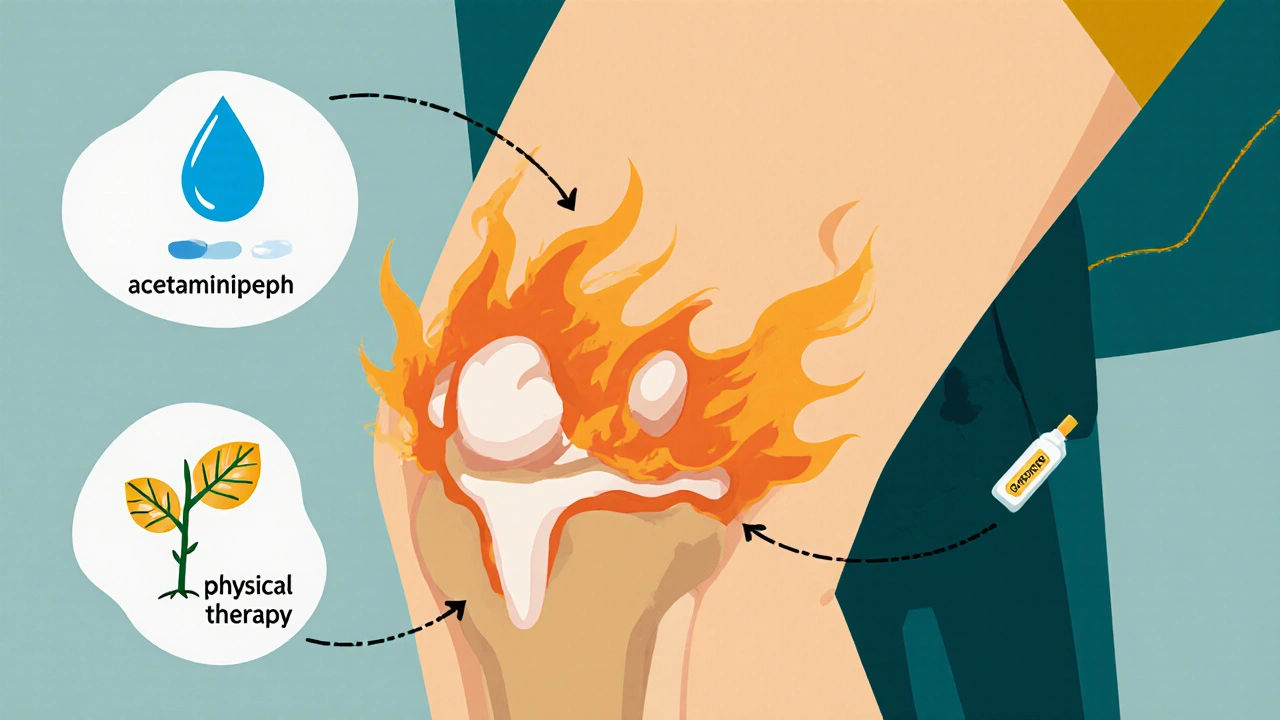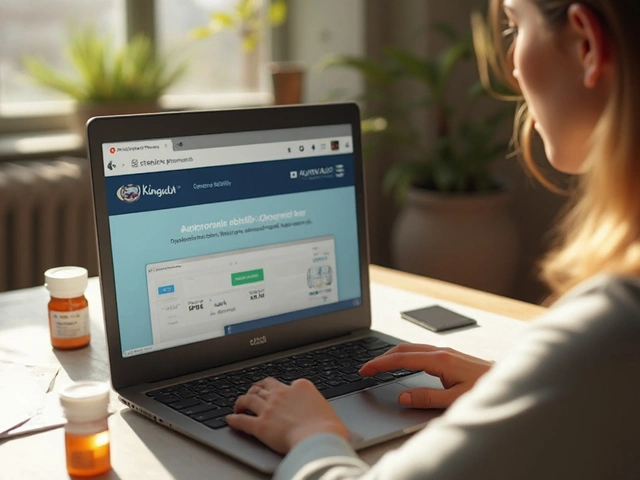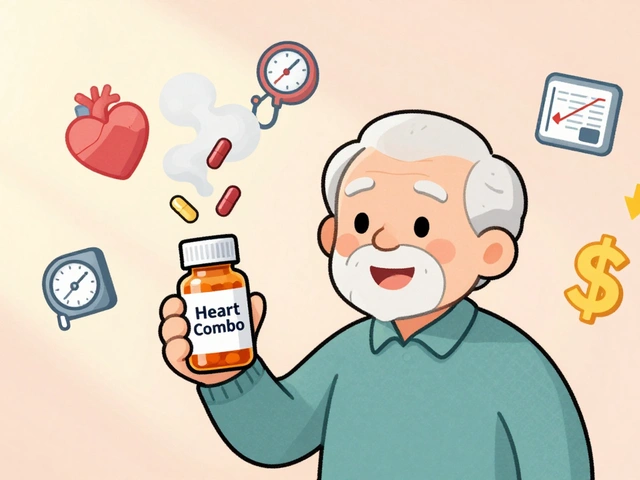Pain Relief Decision Tool
Find Your Best Pain Relief Alternative
Answer a few questions to get a personalized recommendation based on the latest medical research.
1. What type of pain are you experiencing?
Diclofenac is one of the most commonly prescribed NSAIDs for pain and inflammation. You’ve probably seen it in bottles labeled Voltaren, Cataflam, or just plain diclofenac sodium. It works fast-often within 30 minutes-and can knock down joint pain, muscle strains, or even migraine headaches. But it’s not without risks. Stomach ulcers, heart issues, kidney strain-these aren’t just fine print. They’re real dangers, especially if you’re over 60, take it long-term, or have existing health conditions.
Why People Look for Diclofenac Alternatives
People switch from diclofenac for three main reasons: side effects, cost, or lack of results. A 2023 study in The Lancet Rheumatology found that nearly 28% of patients stopped taking diclofenac within six months because of stomach upset or high blood pressure. Others simply can’t afford it-brand-name versions can cost over $100 a month without insurance. And some just don’t feel better, no matter how long they try.
If you’re on diclofenac and wondering if there’s something safer, gentler, or cheaper, you’re not alone. Let’s break down the most common alternatives and how they stack up.
Ibuprofen: The Over-the-Counter Go-To
Ibuprofen is everywhere: Advil, Motrin, store brands. It’s the most popular NSAID you can buy without a prescription. Compared to diclofenac, ibuprofen is milder but also safer for short-term use. It’s less likely to cause stomach bleeding or raise blood pressure as dramatically.
Here’s the catch: ibuprofen doesn’t last as long. You’ll need to take it every 4 to 6 hours. Diclofenac, especially in extended-release form, can be taken just twice a day. For chronic conditions like osteoarthritis, that convenience matters. But if you only need pain relief for a sprained ankle or a bad headache, ibuprofen gets the job done without the heavy risk profile.
One study from the University of Toronto tracked 1,200 patients over a year. Those on ibuprofen had 40% fewer gastrointestinal complications than those on diclofenac. If you’re looking for a low-risk daily option, ibuprofen is a solid first choice.
Naproxen: The Long-Lasting Option
Naproxen-sold as Aleve or Naprosyn-is the middle ground between ibuprofen and diclofenac. It lasts longer than ibuprofen (up to 12 hours per dose) but isn’t as potent as diclofenac. It’s also one of the few NSAIDs that’s been shown in multiple studies to have a lower risk of heart attack compared to diclofenac.
A 2024 meta-analysis in BMJ reviewed data from 13 clinical trials and found naproxen had the lowest cardiovascular risk among all NSAIDs tested. That’s why doctors often recommend it for people with a history of heart disease who still need strong pain relief.
But naproxen isn’t perfect. It still carries stomach risks, and if you take it daily for more than 10 days without medical supervision, you’re increasing your chance of kidney damage. Still, for someone with chronic back pain or rheumatoid arthritis, naproxen offers a good balance of effectiveness and safety.
Celecoxib: The COX-2 Selective Alternative
Celecoxib (Celebrex) is different. It’s a COX-2 inhibitor, meaning it targets inflammation without hitting the stomach lining as hard. That’s why it’s often prescribed to people who’ve had ulcers from other NSAIDs.
It works just as well as diclofenac for arthritis pain. In fact, a 2022 head-to-head trial showed no significant difference in pain reduction between celecoxib and diclofenac over 12 weeks. But celecoxib caused 60% fewer stomach ulcers.
Here’s the trade-off: celecoxib still carries a heart risk. It’s not safer than diclofenac when it comes to heart attacks or strokes. And it’s expensive-often $200+ per month without insurance. Generic versions help, but not everyone can access them. If you’ve had a stomach ulcer and need long-term relief, celecoxib might be worth the cost. But if you’re healthy and just want to manage occasional pain, it’s overkill.

Acetaminophen: Not an NSAID, But Still Useful
Acetaminophen (Tylenol) doesn’t reduce inflammation. That’s important. If you have swollen knees from arthritis, it won’t shrink the swelling. But it does block pain signals in the brain, and it’s much gentler on your stomach and kidneys than any NSAID.
For mild to moderate pain-headaches, backaches, dental pain-acetaminophen is often the first recommendation from the American College of Rheumatology. It’s cheap, widely available, and safe if you don’t exceed 3,000 mg per day. People with liver disease or who drink alcohol regularly should avoid it, but for most others, it’s the safest daily option.
Some doctors combine acetaminophen with a low-dose NSAID for better pain control. That way, you get the anti-inflammatory punch without the full dose of risk.
Topical Options: Diclofenac Gel and Beyond
If you’re taking diclofenac pills and getting stomach problems, try the gel. Diclofenac topical gel (Voltaren Arthritis Pain) delivers the drug right to your sore joint-knee, elbow, wrist-with far less entering your bloodstream. Studies show it’s as effective as oral diclofenac for localized pain but with 90% fewer systemic side effects.
Other topical options include capsaicin cream (from chili peppers), menthol rubs, and lidocaine patches. These won’t fix inflammation, but they can numb the pain enough to let you move better. For older adults with osteoarthritis in one or two joints, topical treatments are often the best first step.
Non-Drug Alternatives: What Actually Helps
Medication isn’t the only tool. Physical therapy, weight loss, and exercise reduce inflammation naturally. A 2025 study in Arthritis Care & Research showed that people with knee osteoarthritis who did 150 minutes of walking or swimming per week reduced their need for NSAIDs by 57%.
Heat and cold therapy, braces, and even acupuncture have shown measurable benefits in clinical trials. If you’re relying on diclofenac every day, you’re treating the symptom, not the cause. Working with a physical therapist or occupational therapist can give you tools that last longer than any pill.

When to Stick With Diclofenac
That said, diclofenac still has its place. For severe inflammatory conditions like ankylosing spondylitis or acute gout attacks, it’s often more effective than other NSAIDs. Some patients simply respond better to it. If you’ve tried alternatives and they didn’t help, diclofenac might still be your best option.
The key is using it wisely: lowest effective dose, shortest possible time, and never without regular checkups. Your doctor should monitor your blood pressure, kidney function, and liver enzymes every 6 to 12 months if you’re on long-term diclofenac.
Choosing the Right Alternative for You
Here’s a quick guide to help you decide:
- For occasional pain, low risk: Ibuprofen or acetaminophen
- For chronic pain, heart concerns: Naproxen
- For chronic pain, stomach ulcers: Celecoxib (if affordable)
- For joint pain in one area: Diclofenac gel
- For overall safety and no inflammation: Acetaminophen
There’s no universal best. What works for your neighbor might not work for you. Your age, other medications, kidney health, and type of pain all matter.
What to Ask Your Doctor
Before switching, ask:
- Why was diclofenac chosen for me?
- What side effects should I watch for?
- Are there non-drug options I haven’t tried?
- Can we try a lower dose or a topical version first?
- How often should I get blood tests?
Don’t just swap pills on your own. Mixing NSAIDs or doubling up with aspirin can be dangerous. Even switching from one NSAID to another requires medical guidance.
Final Thoughts
Diclofenac is powerful-but power comes with responsibility. There are safer, cheaper, and sometimes more effective ways to manage pain. You don’t have to suffer just because you’ve been told to take a pill. Start with the least risky option. Try topical gels. Add physical therapy. Talk to your doctor about alternatives. Pain doesn’t have to mean pills. Sometimes, it just means a better plan.
Is diclofenac stronger than ibuprofen?
Yes, diclofenac is generally stronger than ibuprofen for inflammation and chronic pain. It’s often prescribed for conditions like rheumatoid arthritis or severe back pain where ibuprofen doesn’t provide enough relief. But strength doesn’t mean safety. Ibuprofen has a better safety profile for short-term use, especially for people without existing health risks.
Can I take naproxen instead of diclofenac?
Yes, naproxen is a common substitute. It’s less likely to raise blood pressure or cause heart problems than diclofenac, making it a preferred option for people with cardiovascular risks. Naproxen lasts longer (up to 12 hours), so you take it fewer times a day. But it still carries stomach and kidney risks, so don’t take it daily without medical supervision.
Is celecoxib safer than diclofenac?
Celecoxib is safer for your stomach-it causes far fewer ulcers than diclofenac. But it’s not safer for your heart. Both carry similar risks of heart attack and stroke. Celecoxib is best for people who’ve had stomach issues from other NSAIDs. If you don’t have a history of ulcers, it’s usually not worth the higher cost.
What’s the safest pain reliever for long-term use?
For long-term pain without inflammation, acetaminophen is the safest option-when used under 3,000 mg per day. For inflammatory pain, topical diclofenac gel or naproxen (at the lowest effective dose) are better than oral NSAIDs like diclofenac. Always combine medication with physical therapy and lifestyle changes to reduce reliance on pills.
Can I use diclofenac gel instead of pills?
Yes, if your pain is localized-like in your knee, elbow, or wrist-diclofenac gel is a great alternative. It delivers the drug directly to the sore area with minimal absorption into your bloodstream. That means far fewer stomach, kidney, or heart risks. Studies show it works just as well as pills for joint pain, but with 90% fewer side effects.






Wiley William
29 October, 2025 . 08:22 AM
Diclofenac is just the pharmaceutical industry’s way of keeping you hooked while they profit off your pain
They know people will take it daily because it works too well-so they bury the heart risks in tiny font
Ever wonder why the FDA keeps approving it? Same reason they let Big Pharma push opioids-money over lives
And don’t even get me started on the ‘topical gel’ scam-it’s still diclofenac, just slower poison
They’ll sell you a $70 tube and call it ‘safe’ while your kidneys slowly die
Wake up people-this isn’t medicine, it’s corporate manipulation wrapped in a prescription
Tim H
31 October, 2025 . 00:01 AM
so i tried naproxen after my doc switched me from diclofenac and honestly it was a total game changer
no more stomach cramps and my knees actually feel better
but i totally spaced and took it for 14 days straight-oops
got a weird tingling in my hands and had to go to urgent care
turns out my kidney levels were kinda high
so yeah-naproxen’s good but don’t be like me and just wing it
also the generic is like 4 bucks a month-why are people paying for brand name??
Umesh Sukhwani
31 October, 2025 . 10:08 AM
While the comparative analysis presented is scientifically robust and well-structured, I wish to emphasize the cultural context in which pain management is perceived in India
Many individuals rely on traditional remedies such as turmeric paste, warm oil massage, or Ayurvedic formulations before considering NSAIDs
Even when prescribed diclofenac, adherence is often inconsistent due to cost and fear of side effects
It is encouraging to see non-pharmacological approaches such as physical therapy being highlighted
These methods align closely with holistic healing traditions and should be integrated more systematically into primary care
Vishnupriya Srivastava
31 October, 2025 . 10:50 AM
Interesting how the article ignores the role of gut microbiome in NSAID tolerance
Recent studies show that people with low microbial diversity are 3x more likely to develop ulcers on NSAIDs
Probiotics aren't a magic fix, but they do help reduce gastric irritation
Also-acetaminophen isn't 'safe' for everyone
Chronic use even at 3g/day can cause silent liver fibrosis-especially in people with metabolic syndrome
Most doctors never check ALT/AST unless you're drunk or overdosed
So yes, it's 'safer'-but not risk-free
Matt Renner
31 October, 2025 . 22:53 PM
As a primary care provider with over 15 years of experience managing chronic pain, I can confirm the recommendations in this post are clinically sound
Topical diclofenac is underutilized-especially in elderly patients with localized osteoarthritis
It reduces systemic exposure by over 90% and is often covered by insurance without prior authorization
For patients with a history of GI bleeding, I routinely switch to naproxen or celecoxib with a PPI
But I always pair medication with a referral to physical therapy
Medication alone is a band-aid; movement is the cure
Patients who engage in even 20 minutes of daily walking report significantly better long-term outcomes
Ramesh Deepan
1 November, 2025 . 05:55 AM
Great breakdown, but I want to add something real-pain is personal
I had a friend who tried every NSAID under the sun and nothing worked until he tried low-dose diclofenac
He’s 72, has diabetes, and takes it once a day-no issues
His doctor monitors him every 4 months, he drinks water like a camel, and he walks every morning
So don’t let fear stop you from trying something that might help
But also don’t be lazy-don’t just pop pills and sit on the couch
Find what works for YOUR body, not what worked for your cousin or that guy on Reddit
And always, always talk to your doctor before making changes
Wayne Rendall
1 November, 2025 . 13:04 PM
It is worth noting that the cardiovascular risk profile of NSAIDs is not uniform across all populations
Recent meta-analyses indicate that naproxen’s relative safety in terms of thrombotic events is most pronounced in individuals with pre-existing hypertension or hyperlipidaemia
Conversely, celecoxib may confer a higher risk in patients with established coronary artery disease
Furthermore, the dose-response relationship for gastrointestinal injury is linear and dose-dependent across all NSAIDs
Therefore, the principle of ‘lowest effective dose for shortest duration’ remains paramount, regardless of agent selected
Ifeoluwa James Falola
3 November, 2025 . 08:39 AM
Topical gel works. I use it for my elbow.
No stomach issues.
Costs less than pills.
Try it first.
Adam Phillips
5 November, 2025 . 06:03 AM
What if pain isn't a problem to be solved but a signal to be listened to
We treat pain like an enemy to be silenced with chemicals
But what if it's the body screaming for rest movement hydration connection
Diclofenac doesn't fix the broken joint
It just makes you forget it's broken
And then you keep using it until it breaks more
Maybe the real alternative is learning to slow down
Not just swapping one pill for another
Julie Lamb
7 November, 2025 . 00:55 AM
I switched to acetaminophen after my stomach nearly gave out on diclofenac
It’s not perfect but it’s kept me off the ER
And I started doing yoga twice a week-my back pain has cut in half
Also, I cry more now and it helps? Like, I just let myself feel the ache instead of fighting it
It sounds weird but I feel lighter
Also I use a heating pad and it’s like a hug for my spine 💕
april kakoske
7 November, 2025 . 17:20 PM
My mom took diclofenac for 8 years
She didn’t know her kidneys were failing until she collapsed
Now she uses the gel and walks every morning
She says she feels more alive than she has in decades
It’s not about the pill
It’s about the life you live around it
Be gentle with your body
It’s been carrying you this whole time